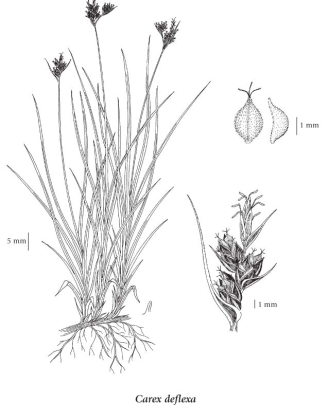Click on the image below to view an
expanded illustration for this species.

|
General:
Perennial, loosely tufted herb from slender, creeping, branched rhizomes; stems 5-25 cm tall, densely clustered, longer than or sometimes equalling the leaves, purple-tinged at the bases.
Leaves:
Sheaths tight, persistent; blades flat, channeled above, smooth or somewhat rough, borne on the lower 1/3 of the stem, 1-2 mm wide, the lower ones slightly reduced.
Flowers:
Spikes 2 to 6, the terminal one unstalked or short-stalked, 2-5 cm long, with male flowers, the lower spikes few-flowered, with female flowers, unstalked to short-stalked, 2 to 4 of these borne near the male spike and 1 or more usually borne near the bases of the stems, erect; bracts subtending the female spikes leaflike, sheathless or short-sheathing, shorter than to 4 times as long as the male spike, longer than the inflorescence, the upper bracts reduced.
Fruits:
Perigynia elliptical to broadly egg-shaped, 2-3 mm long, 0.5-1.5 mm wide, greenish to straw-coloured, convex, finely short-hairy, with 2 prominent marginal nerves, the bases short-stalked, the beaks short and inconspicuous to slender and 0.4-0.7 mm long, bidentate; female scales egg-shaped and pointed on the upper perigynia to broadly lanceolate and awned on the lower perigynia, usually shorter and somewhat wider than the perigynia, purplish-brown, with lighter midribs and translucent margins; stigmas 3; achenes 3-angled, smooth, 1.5-2 mm long.
Notes:
Closely related to C. rossii, these two taxa are sometimes considered conspecific. In that case C. deflexa (the oldest name in the complex) is used in a broad sense (e.g., Taylor 1983).
Source: The Illustrated Flora of British Columbia
|

